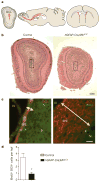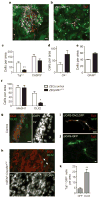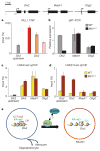Chromatin remodelling factor Mll1 is essential for neurogenesis from postnatal neural stem cells
- PMID: 19212323
- PMCID: PMC3800116
- DOI: 10.1038/nature07726
Chromatin remodelling factor Mll1 is essential for neurogenesis from postnatal neural stem cells
Abstract
Epigenetic mechanisms that maintain neurogenesis throughout adult life remain poorly understood. Trithorax group (trxG) and Polycomb group (PcG) gene products are part of an evolutionarily conserved chromatin remodelling system that activate or silence gene expression, respectively. Although PcG member Bmi1 has been shown to be required for postnatal neural stem cell self-renewal, the role of trxG genes remains unknown. Here we show that the trxG member Mll1 (mixed-lineage leukaemia 1) is required for neurogenesis in the mouse postnatal brain. Mll1-deficient subventricular zone neural stem cells survive, proliferate and efficiently differentiate into glial lineages; however, neuronal differentiation is severely impaired. In Mll1-deficient cells, early proneural Mash1 (also known as Ascl1) and gliogenic Olig2 expression are preserved, but Dlx2, a key downstream regulator of subventricular zone neurogenesis, is not expressed. Overexpression of Dlx2 can rescue neurogenesis in Mll1-deficient cells. Chromatin immunoprecipitation demonstrates that Dlx2 is a direct target of MLL in subventricular zone cells. In differentiating wild-type subventricular zone cells, Mash1, Olig2 and Dlx2 loci have high levels of histone 3 trimethylated at lysine 4 (H3K4me3), consistent with their transcription. In contrast, in Mll1-deficient subventricular zone cells, chromatin at Dlx2 is bivalently marked by both H3K4me3 and histone 3 trimethylated at lysine 27 (H3K27me3), and the Dlx2 gene fails to properly activate. These data support a model in which Mll1 is required to resolve key silenced bivalent loci in postnatal neural precursors to the actively transcribed state for the induction of neurogenesis, but not for gliogenesis.
Figures




References
-
- Hsieh J, Gage FH. Epigenetic control of neural stem cell fate. Curr Opin Genet Dev. 2004;14:461–469. - PubMed
-
- Schuettengruber B, Chourrout D, Vervoort M, Leblanc B, Cavalli G. Genome regulation by polycomb and trithorax proteins. Cell. 2007;128:735–745. - PubMed
-
- Fasano CA, et al. shRNA knockdown of Bmi-1 reveals a critical role for p21-Rb pathway in NSC self-renewal during development. Cell Stem Cell. 2007;1:87–99. - PubMed
-
- Lim DA, et al. In vivo transcriptional profile analysis reveals RNA splicing and chromatin remodeling as prominent processes for adult neurogenesis. Mol Cell Neurosci. 2006;31:131–148. - PubMed
Publication types
MeSH terms
Substances
Grants and funding
LinkOut - more resources
Full Text Sources
Other Literature Sources
Medical
Molecular Biology Databases

